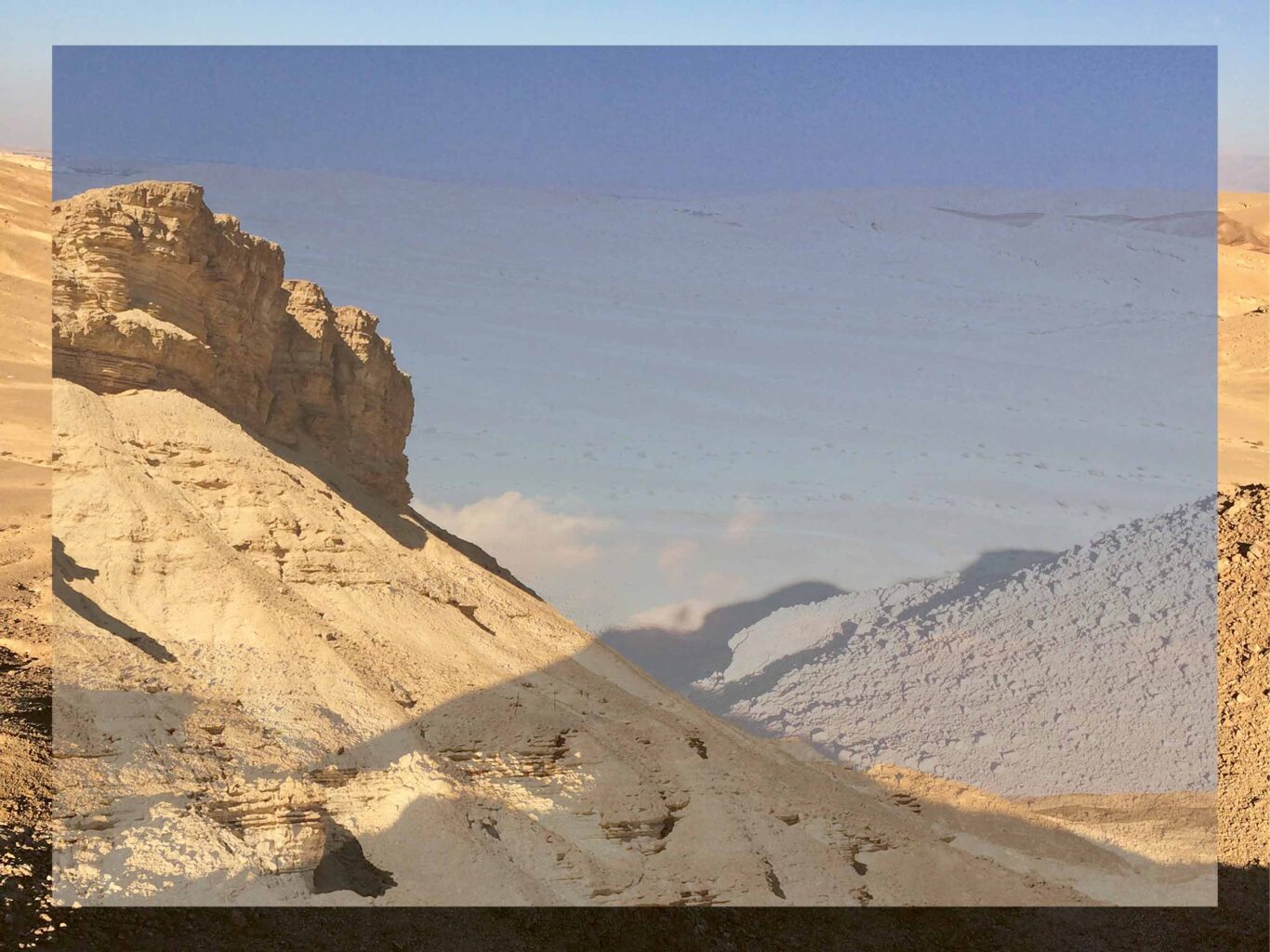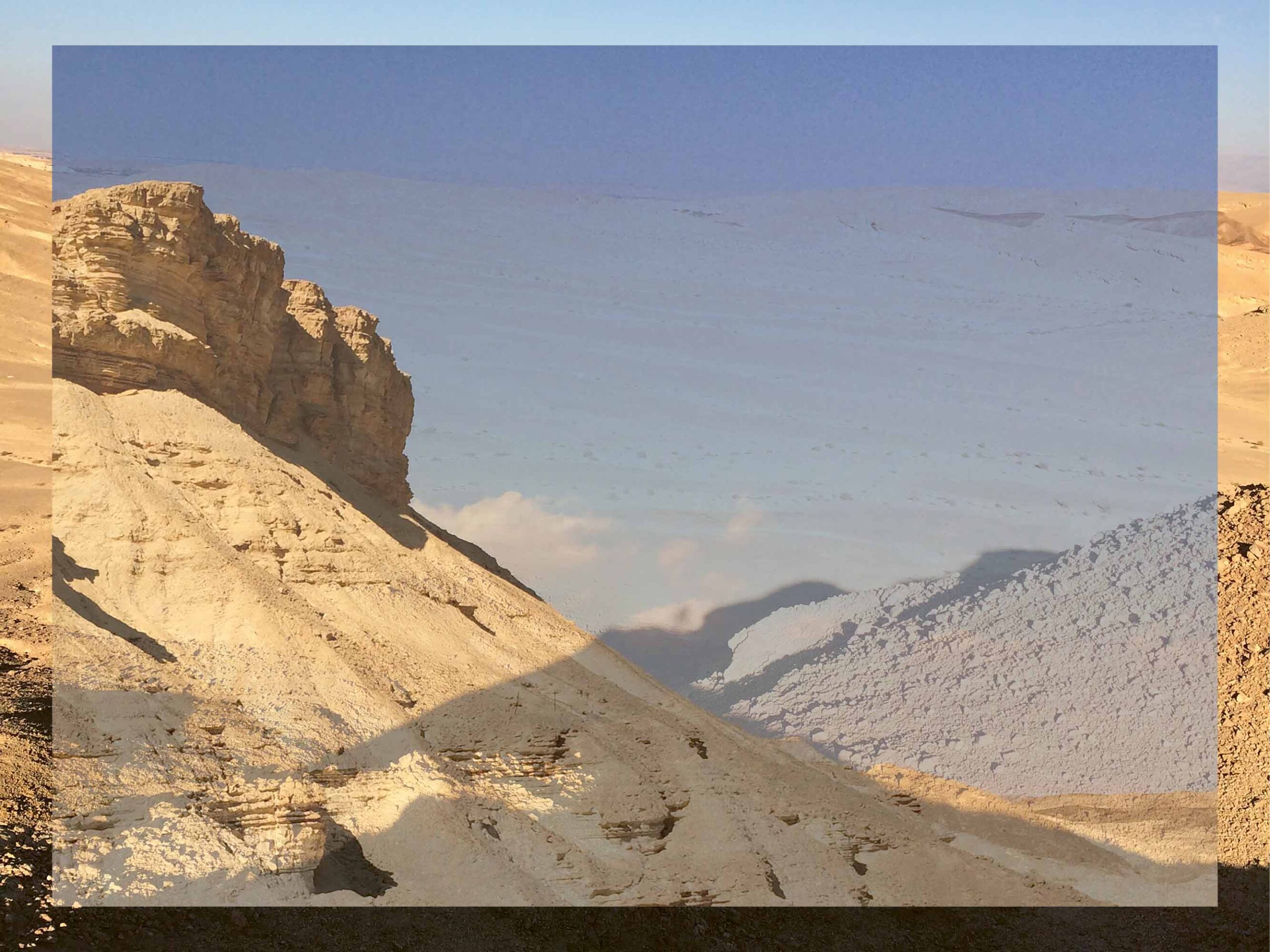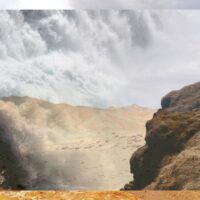A travel diary from the Arava and Negev deserts in Israel, spring 2023.
I am wandering. For years, in my mind’s eye, I’ve been seeing myself trekking through the desert—through mountains of sand, a figure wrapped in cloths, always just moving on. Where this feeling comes from, I don’t know, but twice this March, I had an opportunity to travel to the Arava and Negev deserts in the south of Israel.
When I explore these inner images, one aspect comes back again and again: the fire that permeates the earth. Then, my longing for this purified space arises anew. It is the image of catharsis in landscape form, stripping away all that is superfluous, all that is excessive. Here, as a human being, you are cut down to the essentials. Life counts for little if it is not inward or spiritual. No wonder so many met “God” or their demons in the desert. The desert is described as a “hostile” place for life—and it is true, even during these days of travel, lives ended nearby. Despite all the romanticism of the sand, you should not deceive yourself about the existentialism of the desert. A desert is beautiful and cruel for humans. It does not provide much life but puts it to the test.
Its hardness pushes me deep into myself, my body, and its needs. If I cannot permeate the body, it burdens me, especially here. The apparent emptiness of the landscape does not reflect the soul’s multitude of twitches—rather, it makes me step back and become existential.
Feeling the Body
At home, the lush green of the meadows embraces me of its own accord—it extends its shape towards me; it is very loving, caring, and intrusive at the same time. The desert, on the other hand, stays silent. It will not reach out to me, it will not offer me anything, and it will not encourage me.
Nevertheless, the apparent emptiness draws at my interior like a vacuum. In this vastness, breathing is possible again. The stone and rock desert lies before me like a golden brown blanket, as if it wanted to guard the life beneath it, not let it rise up too much and reveal itself. It seems like a higher being sitting in front of the world with its eyes closed—wide awake and silent. Its inner life is magnificent; it has no need to approach me. It is calm and complete in itself. As soon as I am there, a kind of timelessness begins to spread within me. The desire for everything else is forgotten. My soul feels at one with the expansive sound of this silence, with the colorful wasteland that lies before me. Maybe that’s why I long for this part of the earth. Carefully, I explore the stones; I want to touch each and every one of them.
The barren, silent existence of this region pulls me close, unceasingly. I wonder where the urge to touch the desert so much comes from, why the tips of my fingers seek the rough edges of the rocks of their own accord. Why do I want to take my shoes off, in spring when the ground is not yet red-hot at 50 degrees Celsius? Walking barefoot is not wise. Indeed, snakes, scorpions, and lots of thorns are here, too. Nevertheless, my feet want to be out and stand on the soft parts of the big trench where occasional crashing torrents shatter the tranquillity. I climb over some dusty, hard, and polished rocks, and my body is satisfied.
In the evenings, I look into the wadi and see the sun moving behind the mountains and the colors of light, which in this place splash the sky and the ground all the more tenderly. Then I realize I am looking at the earth’s skin, an exposed body that reveals itself to my gaze.

The Desert is the Interior of the World
The earth is naked to be seen; it lies without its green and blue cover, defenseless against the sun and the elements. And yet it is precisely here that it becomes clear how inconceivably powerful this earth is, how little it needs protecting, how its power comes from itself and its sheaths, and the way it blossoms and its greenness are made for us, who cannot muster the same imperial power. The power of the earth is so ferocious that it can make you dizzy when you feel it in the ground. In the Arava desert, its color resembles a gold foundation, strong and glowing.
I find stones with imprints of primeval snail shells and fossilized seashells. These animals turned to stone are like the memories I carry with me. I draw near to the images that are the memories of the earth, testimonies of what once existed in time and has become an image in space. I hold in one hand a few hundred million years of this earthly body—and the earth holds me within itself. The earth holds this body, the 34 years that have been impressed into it and deposited on it.
The earth’s skin gives me a good feeling of the earth as a body, unveiled and unshrouded. A thing hurtling through space, like me. We race through the aeons together, and while I am still marveling it is already over. I have already become a stone shell. The time of the rocks around me is nothing but a blink of an eye in the cosmos.
My body here becomes a land of riddles; I can walk around and through it. The body is an alien homeland like the earth on which I now walk, skin on skin. My body, which lies before me, is closed and finite like any body. The longer I look at the desert, the more its stony skin becomes the world’s death mask. Peace and great freedom emanate from it. Everything has been released. Now, the world is just there. All its aliveness radiates from within.
Penetrating the Earth
I see the earth consumed, an old earth, a world on which life has done its work. Just as the spirit is a fire that destroys the body bit by bit, the aliveness seems to have given way to the earth’s spirituality. The fire has penetrated the stone, liberated it from “life,” and made itself real in the stone. Something seemingly deadly has happened. The more I immerse myself in this image, the more I experience the fire and earth of my body inwardly. They turn into uprightness. A tremendous potential lies in being destroyed and raising yourself up like this. The desert is simultaneously an image of death and the prenatal. There is no apocalypse, only the freedom to fully penetrate this earth myself.
Now, I am walking on the bottom of the primordial seas, where earthly living creatures once began to develop, and I am looking at the antithesis of this beginning, at its remains. Suddenly, the rain comes. Enormous amounts of water flow through the wadi, roads are washed away, and helicopters search for missing people. The sand turns to mud, the gold to greyish brown, and the first gnarled shrubs blossom purple and yellow the next morning.
Where water breaches the desert, another world bursts in. A connection appears out of nowhere—the emptiness and loneliness are filled instantly. It is wonderful, but in this instant, the peace that until a moment ago was my inner space ends. The intimacy of the earth with itself, my intimacy with myself, is over. The connection with the living returns in full force and causes my uprightness to lurch from side to side again, to dance.
Translation Christian von Arnim





